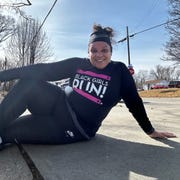It’s common to feel like you’re running out of breath when you’re working out—especially if you’re a new runner, starting again after a break, or running at a harder pace. We’ve all been there.
If this has ever happened to you, you’ve probably wondered: Why do I run out of breath easily? And how can I increase my speed and endurance without breathing so hard?
Well, don’t fret. In fact, take a deep breath because we have the solutions to controlling your inhales and exhales, so you can run fast without running out of breath. Plus, we explain why your breathing can get erratic as you run.
Reasons You Might Run Out of Breath So Easily
Breathlessness is a sign of physical stress. Experiencing shortness of breath while running is a common and usually a benign symptom, but there certainly are more serious reasons for breathlessness, such as allergies, heat and humidity, cardiac disease, respiratory problems, and other more serious health issues. To rule these out, get checked out by your physician to be certain you have a clean bill of health before starting a running journey or increasing your usual training.
Most often, the reason you feel like you’re running out of breath so easily is the result of the intensity associated with the effort of running. In other words, your body is trying hard to meet the increased demands of running.
The primary reason running out of breath happens is due to the buildup of carbon dioxide in the body. As carbon dioxide levels accumulate in the body from exercise, it triggers us to breathe more rapidly via our respiratory system. This allows more oxygen to be taken in. As more oxygen is consumed, carbon dioxide levels are lowered, and when the body achieves a normal level of carbon dioxide, breathing rates return to normal.
Breathlessness may also be due to fatigue of the inspiratory muscles, primarily the diaphragm. Just as we condition and build the endurance of our skeletal muscles, the diaphragm also requires similar conditioning.
Finally, altitude may also cause you to gasp for air midrun, and make you feel as though you’re running out of breath easily. At higher levels of elevation, there is less oxygen available in the air. Your body has to work harder than it does at sea level to find enough oxygen to buffer the buildup of carbon dioxide, thus mirroring the effects of increased intensity even when you’re running at an easier or similar pace as you do at lower elevation.
How to Address Heavy Breathing on the Run
Barring the more serious causes of breathlessness, try making these changes to your running routine to avoid running out of breath.
1. Warm up adequately
Warm up for a minimum of 20 minutes by walking or jogging at a very easy pace. Warming up prepares your body for the workout ahead by gradually increasing your heart rate and breathing rate.
Sweating is a good indication that your body is warm so use that as a guide, and then gradually begin picking up the pace as you move into your training pace. (Our bodies don’t like going from zero to 60!)
2. Practice proper breathing techniques
Improper breathing can be another cause of running out of breath so easily. If breathing is too shallow, it is ineffective and more closely resembles hyperventilation than effective ventilation. Practice breathing deeply when you are not running.
From a seated or standing position, relax, inhale deeply, and exhale completely, dropping your shoulders with the exhalation. As you exhale deeply, force the air out of your lungs, and follow this with a deep inhalation. Some refer to this as “belly breathing” because your abdomen should also rise and fall with deep breathing. Place your hands on your abdomen and see if you feel it moving.
3. Try running indoors on a treadmill
Running in a climate-controlled environment has its benefits as it may help reduce your symptoms due to the lower temperature, lower humidity, and no pollen or other allergens.
4. Incorporate walk breaks in your running
Short walk breaks allow you a brief moment to recover and may give you time to catch up if you’re running out of breath easily. Schedule your walk break intervals before you become breathless.
Set a run-walk interval like running for five minutes, walking for one minute. Repeat this sequence for the duration of your run and see if regular walk breaks at set intervals help reduce or delay the onset of breathlessness.
Address your breathlessness first, then, work on your running speed. Designate one run a week as your speed day. Always include a thorough warmup first and then practice running faster for short intervals of time or distance. These intervals can be on the track, on the road, or done by time. Begin with running faster for one minute, jog easy or walk for one minute, run fast for one minute, jog easy for one minute, etc.
Start with 10 minutes total run time and gradually increase this time by two minutes every other week. When you’re at 20 minutes, then extend the run interval time from one minute to two minutes. The new routine is then run at a faster pace for two minutes, jog easy or walk for one minute, fast for two minutes, easy one minute, and so on.
Increase the run interval time gradually to three minutes, then four minutes, and then five minutes. When you are holding a faster pace for five minutes and recovering for one minute, you can opt to maintain this interval or continue increasing the run time. Just remember: Be patient with yourself and be consistent. You’ve got this.
Watch: Why It’s So Hard to Run a Sub-4 Mile in Colorado
Susan Paul has coached more than 2,000 runners and is an exercise physiologist and program director for the Orlando Track Shack Foundation. For more information, visit www.trackshack.com.


















